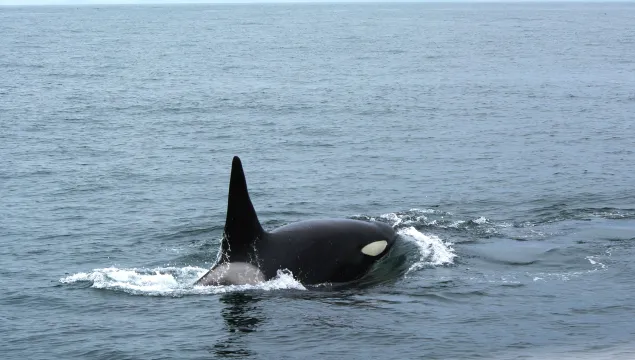Harbour porpoise
Despite being a little shy, these amazing marine mammals can be spotted close to shore in shallow waters. If you do get close, keep an eye out for the loud ‘chuff’ noise they make as they come to the surface to breathe!
Despite being a little shy, these amazing marine mammals can be spotted close to shore in shallow waters. If you do get close, keep an eye out for the loud ‘chuff’ noise they make as they come to the surface to breathe!
These energetic dolphins are often spotted in large groups which will approach boats, bowriding and leaping alongside. At sea, they can form superpods - huge groups made up of thousands of individuals!

Orca, sometimes known as ‘killer whales’, are unmistakable with their black and white markings. Although we do have a small group of orca who live in British waters, you would be lucky to see them!

The moon jelly is the most common jellyfish in UK seas, often washing up on our beaches. No need to worry though - it doesn't sting humans.
Have you ever seen those dark red jelly blobs whilst rockpooling? These incredible creatures are beadlet anemones! They live attached to rocks all around the coast of the UK, the base of their body acting like a sucker to keep them in one place until the tide goes out.
This large anemone is found on rocky shores around the UK and is so called because its green spots and red body means it looks like a strawberry!
It's easy to see where the snakelocks anemone got its name when you spot its flowing tentacles. But be careful when out rockpooling, those tentacles give a nasty sting!
With their beautiful striped tentacles, it's easy to see where dahlia anemones got their floral name from. Look out for them next time you're rockpooling!
Found on rocky shores and seabeds, the Keyhole limpet gets its name from the little hole at the tip of its shell.
If you’ve ever been rockpooling, you’ve probably seen a limpet or two! Their cone-shaped shells clamp onto rocks until the tide comes in, at which point they become active. Limpets move around eating algae using their tough tongue.
The thick topshell is a common sight on rocky shores in Wales and South West England.
These little sea snails are found amongst the seaweed on rocky shores around much of the UK. They come in lots of different colours, from bright yellow to chequered brown!